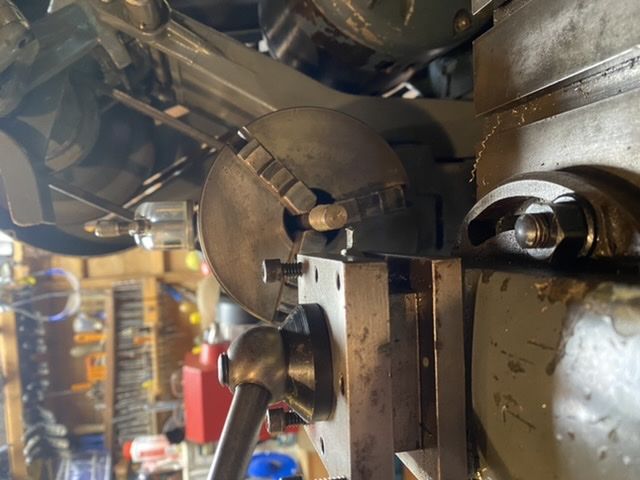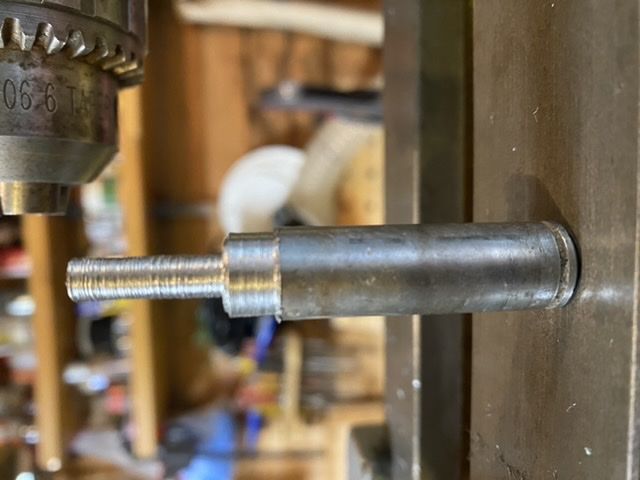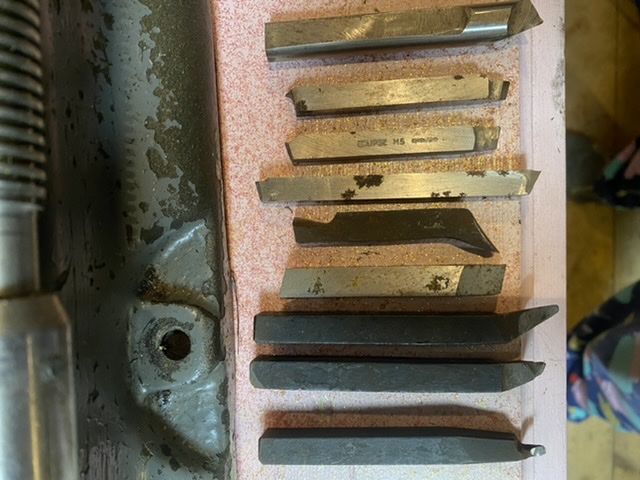Looking at your selection, the tools all seem still serviceable, perhaps with some judicious re-grinding.
The shiny ones are of High-Speed Steel (HSS).
It's not entirely clear to me if some are lying on their sides; so the clearance angle, if that is what it is, on the fourth down is a bit large but that should not matter. For steel and phosphor-bronze, the top of the tool should slope 2-3º or slightly more, diagonally down away from the very cutting-corner. Aluminium – the slightly more. Brass – flat (0º ), giving more scraping than shearing. In all, the flank and front face below the cutting-edge is angled back below itself for clearance.
The top one was perhaps of special purpose, and being round bar, unless there is a flat along its underside it needs to be held in a shallow V-groove pad or a clamp-block, in the tool-post . It might cut neat chamfers.
The dark ones: high-carbon steel (like cold-chisels etc.). Fine, but they will not withstand much heat without losing the temper, spoiling them. That with the long slender "neck" will work into the corner of a wide groove. Next down; a general, and very much used, knife tool for straightforwards turning including facing. No.3's semicircular end may have been for profiling grooves for, e.g., sealing- or oil-retaining rings. Don't try to use it as a parting-tool: it will jam in the cut.
The tool in the middle may be another "special". Hard to see its geometry properly but it might turn the right-hand face of wide grooves, cutting towards the tailstock.
.
Height:
I usually set my lathe tools by pointing them at a centre or scribing-block, then fine-adjust if an initial facing leaves any centre-pip on the metal.
A properly-set tool leaves no pip, but by shaving it down, not shearing the last bit by force (tool too high). If the tool obstinately refuses to remove the pip, it is too low.
A tool-post without height adjustment of its own, such as your 4-way one, needs a good assortment of shims for packing the tools to height. Save expensive "shim stock" for its intended use, aligning machine parts. Instead, off-cuts from ordinary strip or sheet metal, including from food tins, etc.
Even semi-rigid plastic. Some of my shims are from expired plastic bank or club membership cards – a fairly tough, precisely-finished material, so ideal shim where it won't become hot.
Many model-engineers make a simple height-gauge for tool-setting.
.
High-speed steel tools are fine, and have advantages over carbide inserts, not only by being much cheaper. (I use both.). They are relatively easy to sharpen many times to a standard that will give you decent results; and are less fussy than inserts which are really made for quite specific materials and cutting conditions. Some aver insert-tooling can only work at very high speeds, but that is not quite so. They work like that in industry for rapid production at very high repeatability. The HSS tools sometimes give a better finish, especially on steel not of free-cutting grade.
[If the work-piece is to be welded, especially for anything critical, it must not be of a free-cutting steel anyway. Their additives, usually lead, embrittle the weld.]
.
Grinding:
As Calum says, a simple bench-grinder is fine for HSS tools. In fact it is necessary!. It takes some practice but you can grind a tool free-hand to give good results, even on the crude rest usually fitted to these grinders.
A final honing by oil-stone or lapping-plate will help give even better finish, but the finish is mainly dependent on tool geometry, speed, feed and material. The very tip should have at least a tiny radius in plan, even for turning into a shoulder as on your sample.
Hence another caution. If the part is to be heavily-loaded (e.g., a crankshaft, a locomotive driving-axle), internal corners need a little root radius for stress-distribution.
It's worth examining industrially-made parts to see how such principles are applied.
.
I would recommend Harold Hall's Tool & Cutter Sharpening – lathe-tools, drills and in a limited way, milling-cutters; No. 38 in the Workshop Practice Series by Special Interest Model Books. (www.specialinterestmodelbooks.co.uk). Buy from them, or as as I did, from TEE Publishing. Mr. Hall's book gives designs for attachments to turn a simple bench-grinder into a moderately comprehensive tool-&-cutter grinder – useful exercises as a bonus. Just a simple plate adjustable for angle in both directions, on brackets screwed to the bench in front of a grinder itself screwed down, will greatly facilitate sharpening lathe-tools.
It goes without saying the grinder should be well away from any machine tools!
Also note that with perhaps some specific, controlled exceptions (see the book's cover photograph!) the side of a grinding wheel should not be used. The concave radius from the wheel's rim does not normally matter.
.
Cutting Fluid:
A cutting fluid is a coolant and lubricates the cutting action, for steel, phosphor-bronze and aluminium; and can help maintain a decent quality of finish (with all other criteria met). Cut brass and cast-iron dry – note as another thread here discusses, cast-iron chips are abrasive.
Steel and bronze: one of the water-soluble oils, pumped or gravity-fed to the tool tip; or applied with an old paint-brush. For Aluminum: paraffin, white spirit or WD-40 (which is mainly white spirit); but note that these will wash out lubricating oil from the lathe. (WD-40 is not a lu
Edited By Nigel Graham 2 on 31/05/2
Nigel Graham 2.







